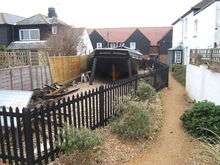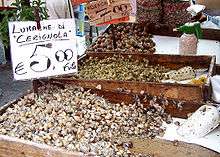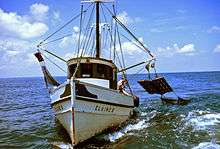Whitstable Museum and Gallery
Whitstable Museum and Gallery is a heritage centre in Whitstable, Kent, with displays showing the history of the local oyster trade started by the Romans and of historical diving equipment.
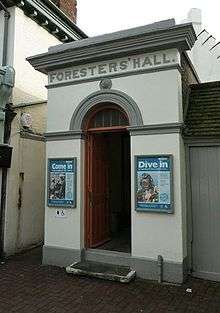 Museum entrance | |
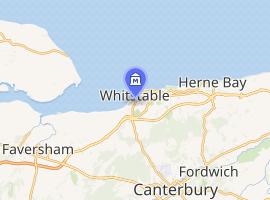
| |
| Established | 1985 |
|---|---|
| Location | 5A Oxford Street, Whitstable, Kent CT5 1DB, United Kingdom |
| Type | heritage centre; seafaring traditions museum |
| Collection size | Diving, oyster trade, shipbuilding trade, Peter Cushing |
| Curator | Joanna Jones |
| Public transit access | Rail: Whitstable railway station Buses: National Express, Stagecoach |
| Website | www |
History
The present museum was established in 1985.[1][2][3] The museum received the Nautiek Award, for services to diving history, in 2001; the first time the award had been given to a UK establishment.[4] In 2015, the museum was reopened following a refurbishment, part-funded by a £15,000 grant from Arts Council England. [5]
The building's small doorway opens up into a large hall of displays.[6] In 1881, the Ancient Order of Foresters bought the building, and inscribed "Foresters' Hall" over the door.[7]
Exhibits
The museum has collections and displays on themes of the natural world, local oyster trade, early diving and the actor, Peter Cushing, who lived locally,[8] as well as displays on the 1953 floods, shipwrecks and maritime archaeology. The collections are held under the following headings: social history, science and technology, maritime, land transport, fine art, decorative and applied art, archives and archaeology.[8][9]
The natural world display shows life on the shoreline, including plants, fossils, sealife and birds.[4]
The museum's largest object is Whitstable's first horse-drawn fire pump, which was manned by twenty-six volunteers. In 1867, the Norwich Union Fire Insurance Society had donated it to the town.[11] The diving display shows standard diving dress with Siebe Gorman helmet and the traditional red bonnet to protect the head against the helmet (see image below). The museum also contains relics from the East Indiaman Hindostan, which wrecked at Margate in January 1803.
In 2010, the BBC chose the pudding pan pots from Whitstable Museum as objects illustrating the history of Kent as part of the A History of the World in 100 Objects project.[12][13][14][15]
The museum provides object identification services, and holds specialist publications on its collections. Facilities are available by advance booking for study of objects from the collections.[4]
 Museum entrance
Museum entrance Display hall, looking towards entrance
Display hall, looking towards entrance Display hall, looking from entrance
Display hall, looking from entrance 1867 fire pump
1867 fire pump Courtyard garden
Courtyard garden Diving display
Diving display
 Modern oyster fishing at Whitstable, 2007
Modern oyster fishing at Whitstable, 2007
Gallery
The collection includes: ship paintings on the theme of international and local trading links; town, shore and coastal views; the work of local artists; and artworks borrowed from an international network of galleries.[4][8]
Events
Exhibitions
There are about six exhibitions per year: some local, some which have toured nationally, and some with associated public events.[17] In 2001, there was a special exhibition about art and water.[18] In March 2002, there was an exhibition in which visitors could handle historic diving equipment and watch films about diving.[19] There was a 2009−2010 exhibition on the last oyster yawl, Favourite, and a Girl Guides exhibition in 2010.[17] The museum takes part in the annual Whitstable Oyster Festival by hosting interactive exhibitions.[20] In September 2009, the museum had a World War II frontline exhibition.[21]
Workshops
Workshops are provided for schools and colleges, and students can study with practising artists. Adult courses, and a children's "Little Oysters Story Time" are held in addition.[4][8][17] In 2015, the museum hosted the Whitstable Museum of Fun with workshops to make models of Daleks, the 1830 Invicta locomotive and oyster grotters.
Educational space
The museum re-allocated some of its space for education in 2009 on its frontage with Oxford Street.[22][23] In the event the Council voted in favour of this proposal.[24][25]
References
- Information from museum spokesperson
- "March 2014 – The Whitstable Society". Retrieved 3 May 2020.
- "Visual Arts Data Service". Retrieved 3 May 2020.
- "Whitstable Museum & Gallery". Culture 24. Retrieved 3 February 2010.
- "Museum to reopen amid transfer delays". 28 June 2015. Retrieved 10 October 2019.
- Fray, Pam (5 February 2010). "TR1066 : Inside Whitstable Museum". Geograph. Retrieved 6 February 2010.
- Fray, Pam (5 February 2010). "TR1066 : Entrance to Whitstable Museum and Art Gallery, Oxford Street". Geograph. Retrieved 6 February 2010.
- "Whitstable Museum & Art Gallery". AboutBritain.com. 1999–2010. Retrieved 3 February 2010.
- "Whitstable Museum & Gallery". modellskipper.de. 2000–2010. Retrieved 3 February 2010.
- Fray, Pam (5 February 2010). "TR1066: Whitstable's first fire engine". Geograph. Retrieved 6 February 2010.
- "Blue Town anchor plays a part in Kent's history". Kent Messenger: Kent Online. 22 January 2010. Retrieved 21 February 2010.
- "Roman shipwreck pots used for puddings". BBC: A History of the World. 2010. Retrieved 21 February 2010.
- "Kent's 10 objects that tell the story of history". YourCanterbury.co.uk. 31 January 2010. Archived from the original on 28 February 2010. Retrieved 24 October 2016.
- "Roman pots play their role in world history". Canterbury City Council Online. 18 January 2010. Archived from the original on 30 November 2010. Retrieved 24 October 2016.
- Lilley, Jane. "The Oyster and the Slipper Limpet". British Marine Life Study Society. Retrieved 3 February 2010.
- "Exhibitions and Events (for Whitstable Museum)". Canterbury City Council Online. 2009. Archived from the original on 23 August 2011. Retrieved 3 February 2010.
- "Double vision at Whitstable museum". Canterbury City Council Online. 17 September 2001. Archived from the original on 23 August 2011. Retrieved 24 October 2016.
- "Chance to get insight into history of diving". Kent Online. 25 February 2002. Retrieved 21 February 2010.
- "What's On". Whitstable Oyster Festival. 2010. Archived from the original on 15 July 2009. Retrieved 3 February 2010.
- "Kent's exhibition to explore the Forgotten Frontline of World War II". Kentish Gazette. 8 September 2009. Retrieved 21 February 2010.
- Eyb, Lynette (8 February 2010). "Canterbury's Roman Museum could fall victim to the credit crunch". The Independent. Independent News and Media Limited. Retrieved 8 February 2010.
- Finch, Graham (2008–2010). "Agenda: Executive Thursday, 21st January, 2010 6.30 pm". Canterbury City Council Online. Canterbury: Canterbury City Council. Archived from the original on 8 October 2011. Retrieved 24 October 2016.
- Finch, Graham (19 February 2010). "Agenda Council Thursday, 18th February, 2010 7.00 pm". Canterbury City Council Online. CCC. Archived from the original on 8 October 2011.
- "Canterbury Museums & Hall". City of Canterbury budget 2010−2011. April 2010. Retrieved 22 April 2010.
External links
| Wikimedia Commons has media related to Whitstable Museum. |
